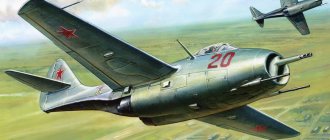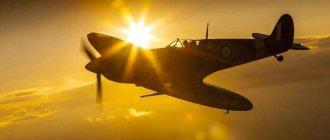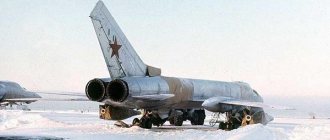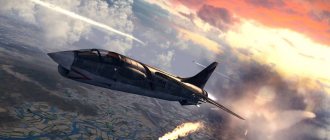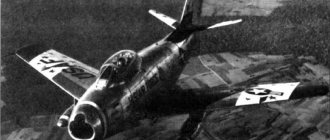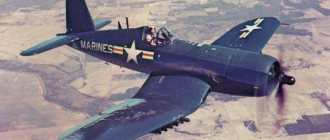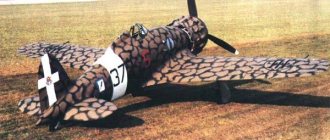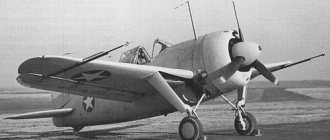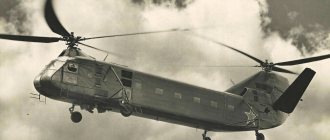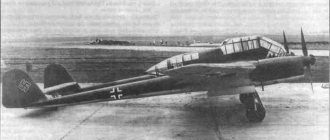Yakovlev Alexander Sergeevich (1906-1989)
Soviet aircraft designer, academician of the USSR Academy of Sciences (1976; corresponding member 1943), colonel general of aviation (1946), twice Hero of Socialist Labor (1940, 1957). In the 20s Yakovlev is one of the founders of Soviet aircraft modeling, gliding and sports aviation; in 1924 he built the AVF-10 glider, which was awarded at all-Union competitions, and in 1927 he built the AIR-1 light aircraft. Since 1924, a mechanic, since 1927, a student at the Red Army Air Force Academy named after. prof. NOT. Zhukovsky (now VVIA); At the same time he designed light aircraft. After graduating from the academy (1931), he became an engineer at an aircraft factory, where in 1932 he formed a light aviation design bureau.
From 1935 chief, in 1956-84 general designer, in 1940-46 at the same time deputy people's commissar of the aviation industry.
Aircraft
- UT-2M. Training aircraft. Yakovlev
- Yak2/BB-22. Close-in bomber. Yakovlev
- Yak-4/BB-22bis. Close-in bomber. Yakovlev
- Yak-6. Light transport aircraft. Yakovlev
- Yak-1. Fighter. Yakovlev
- Yak-7. Fighter. Yakovlev
- Yak-7V. Fighter trainer. Yakovlev
- Yak-1M. Fighter. Yakovlev
- Yak-3. Fighter. Yakovlev
- Yak-9. Fighter. Yakovlev
- Yak-9T tank. Fighter. Yakovlev
- Yak-9D. Long-range fighter. Yakovlev
- Yak-9M. Fighter. Yakovlev
- Yak-9P cannon. Fighter. Yakovlev
- Yak-9PD high-altitude. Fighter. Yakovlev
- Yak-9R. Frontline scout. Yakovlev
- Yak-9U. Fighter. Yakovlev
- Yak-9V. Fighter trainer. Yakovlev
- How to get the best flight data on a Yak aircraft. 1947
Under the leadership of Yakovlev, the UT-2 and UT-1 training aircraft were created, during the Great Patriotic War the Yak-1, Yak-7, Yak-9, Yak-3 fighters, which amounted to about 60% (over 36 thousand copies) of all built during the fighter war years.
After the war, he created the Yak-15, Yak-17, Yak-23, Yak-25, Yak-28 jet fighters; the first Soviet vertical take-off and landing aircraft, the Yak-36 and its combat deck version, the Yak-38; sport aircraft Yak-18, Yak-50, Yak-55; jet passenger aircraft Yak-40 and Yak-42.
Yakovlev was awarded the Lenin Prize (1972), the USSR State Prize (1941, 1942, 1943, 1946, 1947, 1948,1977), and the FAI Gold Aviation Medal. Awarded 10 Orders of Lenin, Orders of Suvorov 1st and 2nd class, French Orders of the Legion of Honor and the Officer's Cross.
MS-21
The development of the MS-21 short- and medium-haul narrow-body passenger aircraft was carried out on the basis of the Yak-242 project, which failed in the 1990s.
MS-21 made its first flight on May 28, 2022. This is the second civil aircraft created from scratch in the modern history of Russia (the first is the regional Sukhoi Super Jet-100, in operation since 2011). The MS-21 differs from it in its longer flight range (maximum 4578 km versus 6400 km) and the number of seats. According to 2022 data, the order portfolio for MS-21 amounted to 315 vessels.
come back
"Douglasenok-2" or about the Yak-16 aircraft
Home » Real story » Little-known and unrealized projects of aircraft and other flying equipment » “Douglasenok-2” or about the Yak-16 aircraft
Little-known and unrealized aircraft projects and other flying equipmentUnrealized aircraft projects.
byakin 01/05/2012 349
0
in Favoritesin Favoritesfrom Favorites 0
After the end of World War II, a rather large niche was formed in the aircraft fleet of the Civil Air Fleet between the light Po-2 and the “mainline” Li-2. To fill it, the civil aviation management wanted to have an aircraft with two 400 hp engines.
In accordance with the requirements of the Civil Air Fleet of 1946, the vehicle was supposed to carry eight passengers over a distance of up to 800 km (ferry range 1200 km) with a cruising speed of 290 km/h (maximum - 370 km/h). In this case, the weight of the commercial load was set to be no less than 900 kg, and the practical ceiling was 7000 m.
Today it is difficult to say for what reasons Civil Air Fleet specialists determined the required engine power for a regional aircraft. However, it is safe to say that the domestic industry has not produced motors of such power. And even if an aircraft was created that complies with the requirements of the Civil Air Fleet, flight safety would sharply decrease if one of the engines fails.
Perhaps the most suitable domestic engine for an aircraft of this type was the ASh-21 with a rated power of 570 hp, created on the basis of the time-tested star-shaped ASh-82FN.
Based on this, the Council of People's Commissars in February 1946 approved the task of developing an aircraft for local lines with ASh-21 engines, while clarifying its data. The document stated that an aircraft with a flight weight of 6,000 kg should carry 10 passengers and 1,000 kg of commercial cargo (in cargo version) over a distance of up to 800 km with a cruising speed of 290 km/h. Its maximum speed was set to be no less than 335 km/h at the ground and 370 km/h at an altitude of 2000 m, and its service ceiling was 7000 m.
It was ordered to build two cars, and present the first copy for state tests on November 1, 1946. However, the OKB, overloaded with tasks, did not meet government deadlines, and in March 1947, the Council of Ministers approved a pilot construction plan for the current year, instructing Yakovlev to build two vehicles (passenger and army) with a crew of two and updated flight performance data. In August 1947, the first of them was ordered to be submitted for state testing.
The differences in the new requirements affected the maximum speed at the ground, which was set at no lower than 350 km/h; the takeoff and mileage should not exceed 400 and 350 m, respectively. For the military version, it was necessary to provide an upper turret with a 20 mm caliber cannon.
When designing the future Yak-16, the main requirements were considered to be flight safety, simple takeoff and landing performance, convenience for passengers, ease of production and the possibility of long-term operation in any region of the Soviet Union.
Layout of the preliminary design of the passenger Yak-16
The machine was just being designed, and for its production, plant No. 464 was identified in the village of Dolgoprudny near Moscow, which, in accordance with the July 1946 order of the MAP, became the production base of the design bureau, headed by A.S. Yakovlev. In order not to interrupt the story, we note that on April 21, 1947, Yakovlev was appointed chief designer of plant No. 464 (by that time it had become experienced), retaining his position as chief designer of OKB-115.
There, in November 1946, a mock-up commission headed by the head of the Civil Air Fleet Research Institute I.F. Petrov worked. Ivan Fedorovich moved up the career ladder quite quickly and already in the fall of the next year, when the act on factory tests of the Yak-16/1 was approved, he was the head of the LII.
At the end of January 1947, the head of the Main Directorate of the Civil Air Fleet F.A. Astakhov approved the protocol of the mock-up commission, signed by its members a couple of months earlier, drawing attention to the two main, as it seemed to him, shortcomings of the machine and demanded to increase the range to 750-800 km taking into account a headwind blowing at a speed of 30 km/h and a fuel reserve for an hour of flight.
Usually the customer discovers many “defects” in the layout. There are many reasons for project defects at the layout stage, but most often the designers do not have enough time...
The Yak-16 was no exception, but, judging by the protocol of the mock-up commission, A.S. Yakovlev agreed to satisfy almost all the customer’s comments. As for the range, here Alexander Sergeevich was categorical:
“The flight range of 800 km with a headwind of 30 km/h was specified according to the TTT and was accurately fulfilled.”
The plane was an all-metal monoplane. Its wing was technologically divided into a rectangular center section and trapezoidal detachable consoles. The power frame of the load-bearing surface was formed by two duralumin I-beams, sets of ribs and stringers. The casing is duralumin.
The fuselage frame is formed by channel-section frames and stringers made of pressed angles. Behind the cabin, luggage and toilet facilities were provided for passengers.
The tail is cantilever with a duralumin frame. The sheathing of the keel, stabilizer and rudder toes is duralumin. The steering wheels are covered with canvas.
Yak-16/I with the number of the Dolgoprudny aircraft plant
The landing gear is tricycle with a tail wheel. Its main supports were attached to the front wing spar and retracted into the engine nacelles. The cantilever-type landing gear with oil-pneumatic shock absorption was folded during cleaning. In the retracted position, the wheels of the main landing gear protruded from the engine nacelles, which made an emergency landing with the landing gear retracted safe.
The main wheels measuring 900x300 mm were brake wheels, and the tail orienting wheel measuring 470x210 mm had an automatic stopper connected to the elevator control.
The aircraft is controlled by a dual control wheel, while the flaps, landing gear, and brakes are pneumatic, backed up by an emergency system, which increases the reliability of the aircraft.
Seven-cylinder air-cooled engines ASh-21 with automatic variable-pitch propellers VISH-111V-20 were installed in engine nacelles made integral with the center section.
Motor mounts are removable, welded from steel pipes, attached to the front frames of the engine nacelles on rubber dampers. The engines were completely hooded, and to regulate their temperature there were entrance shutters and side exit flaps.
To increase the reliability and service life of the engines, the suction pipes of the carburetors had dust filters. Fire extinguishers were provided in case of engine fire.
types of Yak-16/I
The engines were started with a mixture of compressed air and gasoline vapor. Fuel was placed in two center-section tanks with a volume of 450 liters each.
The aircraft was equipped with a full set of instruments, both flight and navigation and engine control.
Factory flight tests of the vehicle began in the fall of 1947. The external similarity of the Yak-16, which appeared at the airfield, with the American "Douglas" DC-3 led to the fact that the car was called "Douglasen", borrowing this name from the Yak-6, produced at the same enterprise.
The vehicle leaders were engineer O.A. Sidorov and pilot F.L. Abramov, co-pilot R.F. Farikh, mechanic P.S. Semin. Over nine days, 32 flights were completed with a total duration of over 18 hours. By the way, Rostislav Fabievich Farikh is the son of the famous polar pilot F.B. Farikh, who worked for many years as a test pilot at plant No. 464 and then moved to the company of V.S. Grizodubova.
LII test pilots S.N. Anokhin and M.L. Gallai flew around the car. The first taxiing took place on September 13, and 11 days later F.L. Abramov took the Yak-16 into the air.
According to pilot Fedor Leontievich Abramov, the Yak-16/I was a modern transport aircraft. In terms of design, layout and technical equipment, it was a great achievement in the domestic experimental aircraft industry. The spacious cockpit created the necessary comfort, and the view from it was excellent. The arrangement of instruments and control levers for motors, flaps and landing gear is convenient.
Yak-16/I layout
While taxiing, the plane was easy to control and had no tendency to turn. The Yak-16/I was easy to maintain in a straight line, even in strong crosswinds. The large anti-crank angle allowed for sharp braking. The depreciation of the car is soft, and the unevenness of the airfield was overcome without shocks.
On takeoff, the car quickly picked up speed and obeyed the steering wheels well. Excess power and flaps greatly shortened the takeoff run and provided a greater rate of climb. This made it possible to operate the mini-liner at airfields of very limited size.
In horizontal flight, the Yak-16/II had a wide range of speeds. Stability relative to all three axes is good, especially on the ground, which is very important for scheduled flights. Stability was tested in rough air conditions; Moreover, even in severe bumps, the aircraft with the controls abandoned maintained the given course for a relatively long time.
The loads on the steering wheels are small. When changing the alignment, additional forces were easily removed with the trimmer in all modes. The supply of rudders is sufficient.
The Yak-16 performed turns steadily and had no tendency to roll or bury its nose. The plane was gliding steadily along a steep glide path. The transition to aging took place smoothly, without drawdown. With all acceptable alignments from 20.5% to 25.5%, the car easily landed on three points.
In the case of a go-around with the flaps extended, the aircraft vigorously gained speed and altitude. During the run the plane is stable. Turns in strong crosswinds were countered by the rudder and brakes.
The ability to fly with one engine stopped, which is the main safety factor of the aircraft, is provided brilliantly. The Yak-16/II easily climbed to 2500 m on one engine. At the same time, the rate of climb reached 2 m/s.
The track stability with one engine stopped was excellent. The load on the pedals was completely removed by the trimmer, and turns were made even in the direction of the switched off engine.
The unexpected failure of one of the motors did not pose a danger. At first, the plane was easily held by the rudder and reverse roll, until the load on the rudder was removed by a slight deflection of the trimmer, after which the straight flight continued without roll.
The Yak-16/I was simple to operate and could be quickly and easily mastered by unskilled pilots. The review of the famous test pilot S.N. Anokhin, who flew around the car in October 1947, is also interesting. The view from the cockpit, according to Sergei Nikolaevich, was good on the ground and in the air. The presence of a window in the ceiling of the cockpit improves visibility from the aircraft when turning compared to other aircraft of this type.
While taxiing, the aircraft is obedient to the pilot's actions. Turning is easy with both the brakes and the motors alone. The brakes are effective and hold the car in place when the engines are running at nominal speed.
During the take-off run, the Yak-16/I steadily maintains the given direction. The supply of all rudders at takeoff is quite sufficient. The plane quickly picks up speed and takes off after a short run at a speed of 90-100 km/h.
Cockpit and passenger compartment of the Yak-16/I
The plane is longitudinally stable, but close to neutral. Laterally stable, but close to neutral. In terms of direction, the aircraft has a large margin of stability. The relationship between track and lateral stability is good.
The loads from the elevator are small and have a direct sign, while the loads from the ailerons are somewhat large and have a positive sign. The loads from the steering wheel are quite permissible and straight according to the sign. Piloting the plane is enjoyable. The overall impression of the aircraft is good.
At the beginning of 1948, the vehicle passed state tests at the Civil Air Fleet Research Institute.
In the spring of 1948, the second army version of the Yak-16/II was built. The engines remained the same, but the propellers were replaced with weathervaned B-511 ones. To combat icing of the propellers and windshields of the cockpit canopy, antifreeze liquid was used.
Unlike its predecessor, the area of the vertical tail was slightly increased and the nose of the fuselage was lengthened, the reinforced cargo compartment floor of which could withstand the load from a concentrated load weighing up to 1000 kg.
The fuselage could accommodate up to seven people with parachutes or up to 10 armed, but without parachutes. In the sanitary version, it was possible to transport up to six wounded on stretchers and one medical worker. For this purpose, there was a large cargo door with a gate on the left side of the fuselage.
A rotating shielded turret UTK-1 with a 12.7 mm UBT machine gun (200 rounds of ammunition) was placed on the fuselage.
Under the wing center section there were suspension units for three TsDMM-120 parachute landing containers. In this case, transportation of up to 500 kg of cargo was allowed in the cargo compartment. The vehicle also had a lock for hooking up the towing cable of the landing glider. The towing version of the Yak-16 was developed in accordance with the order of the ministry.
Factory tests of the Yak-16/II began on the last day of March 1948. Over the course of four weeks, 17 flights were completed with a total duration of about 9.5 hours, after which the vehicle was transferred for state testing.
The vehicle's leaders at the factory testing stage were engineer O.A. Sidorov, pilot F.L. Abramov, co-pilot G.S. Klimushkin and mechanic I.V. Kazamanov.
In the report on the results of factory tests, G.S. Klimushkin noted, in particular:
"Yakovlev-16" with two ASh-21 engines and V-511 feathered propellers is a first-class transport aircraft, the equipment of which allows it to be used in a wide range of flight options. Powerful radio equipment, devices for blind flight, weathervaned propellers, heating and ventilation of the cabin and cargo area, convenient and rational arrangement of control sticks and instruments determine the high degree of technical equipment of the aircraft.
The flight of the aircraft on one engine is carried out without any difficulties.
During taxiing, gliding and cruising, the aircraft is stable. In flight it is stable in all three axes and maintains its heading well. The loads on the control handles and pedals are normal. There is enough rudder reserve in all flight modes. The plane turns steadily and allows turns towards the stopped engine. “Yakovlev-16” is a reliable and easy-to-use machine that is quickly and easily mastered and does not require highly qualified pilots.”
State tests of the military transport Yak-16/II at the Air Force Research Institute revealed a number of inconsistencies between the vehicle and the technical requirements of the military. In particular, on the modified vehicle, to increase the margin of longitudinal stability, it was necessary to increase the area of the horizontal tail and install de-icers on the wing and tail. It was necessary to replace the RPK-10 radio half-compass with an automatic ARK-5 and install a controlled aileron trimmer, a retractable headlight, and eliminate other, albeit minor, issues.
Military transport Yak-16/II
All this made the car heavier. To compensate for weight losses, literally hundreds of grams had to be “scraped out”, improving the design of the Yak-16. In particular, they removed the paratroopers' cables, the orderly's embrasure and parachute flares, abandoned the individual ventilation of the paratroopers, reduced the thickness of the glass and floor of the cargo compartment, as well as the material from which the tail fairings were made.
As a result, the empty aircraft became heavier by only 33 kg, which had to be compensated for in order to maintain the previous normal flight weight by reducing fuel reserves by 10 kg and oil reserves by 5 kg. There were no more reserves.
The Yak-16/II was presented in this form for repeated state tests. However, everything was in vain. Despite numerous positive reviews about the vehicle and the efforts of the Design Bureau, the Yak-16 remained in the category of experienced ones.
The reason for this was the adoption in August 1948 of the An-2 aircraft with the ASh-62IR engine for service and supply to the Civil Air Fleet. This vehicle turned out to be more versatile than the Yak-16, although in the passenger version it was less comfortable. But convenience for passengers in those years did not seem to be of much concern to the final decision makers.
In 1948, both Yak-16s were prepared for the parade in Tushino. The commander of the first of them was the pilot Abramov, and information about the public display of the second vehicle has not yet been found. In the same year, the passenger Yak-16/I was issued a certificate of airworthiness and registered in the state register, assigning it the identification mark USSR-I985, leaving it behind plant No. 464.
Yak-16/I I-985 - exhibit of the fair in Poznan
Under this designation, the aircraft flew abroad for the first time to participate in the 21st fair in Poznan (Poland). As F.L. Abramov said, the Yak-16/l had a chance to visit exhibitions in Hungary and Finland. Judging by the Jane reference book (1950-1951), the plane was also met at airfields in Romania and Czechoslovakia. Later, the Yak-16/l was re-registered and, under the designation USSR-I1074, was operated by pilot plant No. 115.
BASIC DATA OF PASSENGER AND ARMY VARIANTS OF THE YAK-16 S ACCORDING TO THE RESULTS OF FACTORY TESTS
| Set | Yak-16/l | Yak-16/ll | |
| Wingspan, m | — | 21,5 | 21,5 |
| Length, m | — | 15,6 | 16 |
| Parking height, m | — | 4,66 | — |
| Wing area, m² | — | 56,25 | 56,25 |
| Take-off weight, kg | |||
| normal | 6000 | 6021 | — |
| reloading | — | 6230 | 6350 |
| Empty weight, kg | — | 4486 | 4560 |
| Fuel weight, kg | |||
| normal | — | 480 | 550 |
| maximum | — | 540 | 680 |
| Speed max, km/h | |||
| near the ground | 335 | 350 | — |
| at an altitude of 2250 m | 370* | 370 | 352 |
| landing | — | 95 | 105 |
| Climb time 3000 m, min. | 6 | 7 | |
| Practical ceiling, m | 7000 | 7750 | 7100 |
| Range at an altitude of 2000 m, km | 800 | 800 | — |
| Run, m | — | 240 | 185 |
| Mileage, m | — | 250 | 240 |
Note. * At an altitude of 2000 m.
source: Yuri Zasypkin, Nikolai Yakubovich “DOUGLASENOK-2” About the Yak-16 aircraft”, “Wings of the Motherland” 2/2003
Salon and best places
The entrance to the cabin is located at the rear of the aircraft. The plane has 6 emergency hatches. There are toilets in the bow and aft sections of the cabin. The interior layout has two options. With the first, there is business class and economy class, with the second, the layout is one-class, there is only economy class.
With a one-class interior layout, the seats in the first row are considered good, but have some drawbacks. Among the advantages is the absence of seats in front. This means that no one will recline the back, embarrassing the passenger. A positive is the increased legroom. True, not everyone was able to pull them out. The partition is located close.
Salon Yak-42
Disadvantage: the toilet is too close. This is especially inconvenient for passengers in seats “B” and “G”. They border the passage. Here contact with passengers moving along the aisle is possible. Sometimes during a flight, queues for the toilet accumulate in the aisles. They accumulate most often in the first row. It should also be noted the partition located in front. It’s not particularly pleasant to look at her during the entire flight.
The next rows, up to the 6th, are standard. Of course, the chairs in them have their pros and cons, but they are not particularly significant.
Far from the best seats are in the 6th row. The main disadvantage is that the seat backs do not recline. This is done because there is an emergency exit behind.
The best seats are the seats located in the 7th row. Since there is an emergency exit in front of this row, a large empty space allows a person of any height to stretch out with all comfort. Another plus is that since the seat in front is far away, no one will disturb the person sitting with the back reclined.
There are also disadvantages here. But they are not related to comfort. So, you can’t put hand luggage on the floor here. Another minus is the almost complete lack of visibility through the porthole. It can also be called a minus that certain categories of passengers are not allowed to be in this row. These are pregnant women, the elderly, passengers with children, children, foreign citizens who do not know Russian or English well.
The next 5 rows are standard seats. There is no need to talk about any serious pros and cons here.
The backs of the seats in the 13th row are locked. This is an inconvenience, since passengers cannot recline them and are forced to remain in one position throughout the flight. The reason is that there is an emergency exit behind.
In the 14th row there are seats convenient for flying. This includes the presence of large legroom, and the fact that the passenger sitting in front will not recline the back of his chair and create inconvenience.
It is difficult to classify places in rows 15 to 18 as either good or having shortcomings. They are standard.
In row 19, places “B” and “D” have disadvantages. They are located at the aisle. Since the toilet is located nearby, there is a lot of passenger movement here during the flight.
The worst seats in the Yak-42 cabin are those located in the 20th row. The backs of the seats are blocked here. Behind there is a partition. Behind it is a toilet. Moreover, it is so close that passengers can clearly hear the sounds of the drain barrel.
Layout of passenger seats for the Yak-42
Specifications
Below are the performance characteristics of the Yak-130 aircraft.
| Take-off weight, kg: | |
| Normal | 5700 |
| Maximum | 9000 |
| Length, m | 11,49 |
| Wingspan, m | 9,72 |
| Wing area, m2 | 23,5 |
| Height, m | 4,76 |
| Fuel capacity, kg: | |
| Maximum | 1750 |
| maximum with 2 PTB | 2650 |
| Practical range (without PTB), km | 2000 |
| Take-off thrust, kgf | 2x2500 |
| Engine | 2 × AI-222-25 turbojet engine |
| Thrust-to-weight ratio | up to 0.88 |
| Speed, km/h: | |
| maximum for level flight | 1050 |
| takeoff | 200 |
| landing | 195 |
| Run length, m | 380 |
| Run length, m | 670 |
| Maximum flight altitude, m | 12500 |
| Operational overload | +8/-3 |
